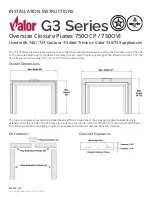
Astria.us.com
126882-01B
8
30,000
+ 10,000
= 40,000
AIR FOR COMBUSTION AND VENTILATION
Continued
DETERMINING FRESH-AIR FLOW
FOR FIREBOX LOCATION
Determining if You Have a Confi ned or
Unconfi ned Space Using the Standard
Method
Use this work sheet to determine if you have
a confi ned or unconfi ned space.
Space:
Includes the room in which you will
install appliance plus any adjoining rooms
with doorless passageways or ventilation grills
between the rooms.
1. Determine the volume of the space (length
x width x height).
Length x Width x Height =__________cu. ft.
(volume of space)
Example:
Space size 22 ft. (length) x 18 ft.
(width) x 8 ft. (ceiling height) = 3168 cu. ft.
(volume of space)
If additional ventilation to adjoining room
is supplied with grills or openings, add the
volume of these rooms to the total volume
of the space.
2. Multiply the space volume by 20 to determine
the maximum Btu/Hr the space can support.
________ (volume of space) x 20 = (Maxi-
mum Btu/Hr the space can support)
Example:
3168 cu. ft. (volume of space) x
20 = 63,360 (maximum Btu/Hr the space can
support)
3. Add the Btu/Hr of all fuel burning appliances
in the space.
Gas water appliance* __________ Btu/Hr
Gas
furnace
__________ Btu/Hr
Vented gas appliance __________ Btu/Hr
Gas
fi replace logs
__________ Btu/Hr
Other gas appliances* + _________ Btu/Hr
Total
=
_________ Btu/Hr
* Do not include direct-vent gas appliances.
Direct-vent draws combustion air from the
outdoors and vents to the outdoors.
Example:
Gas water appliance __________ Btu/Hr
Gas
fi rebox logs
+ _________ Btu/Hr
Total
=
_________ Btu/Hr
4. Compare the maximum Btu/Hr the space
can support with the actual amount of Btu/
Hr used.
_______ Btu/Hr (maximum the space can
support)
_______ Btu/Hr (actual amount of Btu/Hr
used)
Example:
35,840 Btu/Hr (maximum the
space can support)
40,000 Btu/Hr (actual amount of
Btu/Hr used)
The space in the above example is a confi ned
space because the actual Btu/Hr used is more
than the maximum Btu/Hr the space can sup-
port. You must provide additional fresh air.
Your options are as follows:
A. Rework work sheet, adding the space
of an adjoining room. If the extra space
provides an unconfi ned space, remove
door to adjoining room or add ventilation
grills between rooms. See
Ventilation Air
from Inside Building
,
Page 9
.
B. Vent room directly to the outdoors. See
Ventilation Air from Outdoors
,
Page 9
.
C. Install a lower Btu/Hr gas log appliance, if
lower Btu/Hr size makes room unconfi ned.
If the actual Btu/Hr used is less than the
maximum Btu/Hr the space can support, the
space is an unconfi ned space. You will need
no additional fresh air ventilation.
WARNING: If the area in which
the appliance may be operated does
not meet the required volume for
indoor combustion air, combustion
and ventilation air shall be provided
by one of the methods described in
the National Fuel Gas Code, ANSI
Z223.1/NFPA 54, the International
Fuel Gas Code, or applicable local
codes.









































